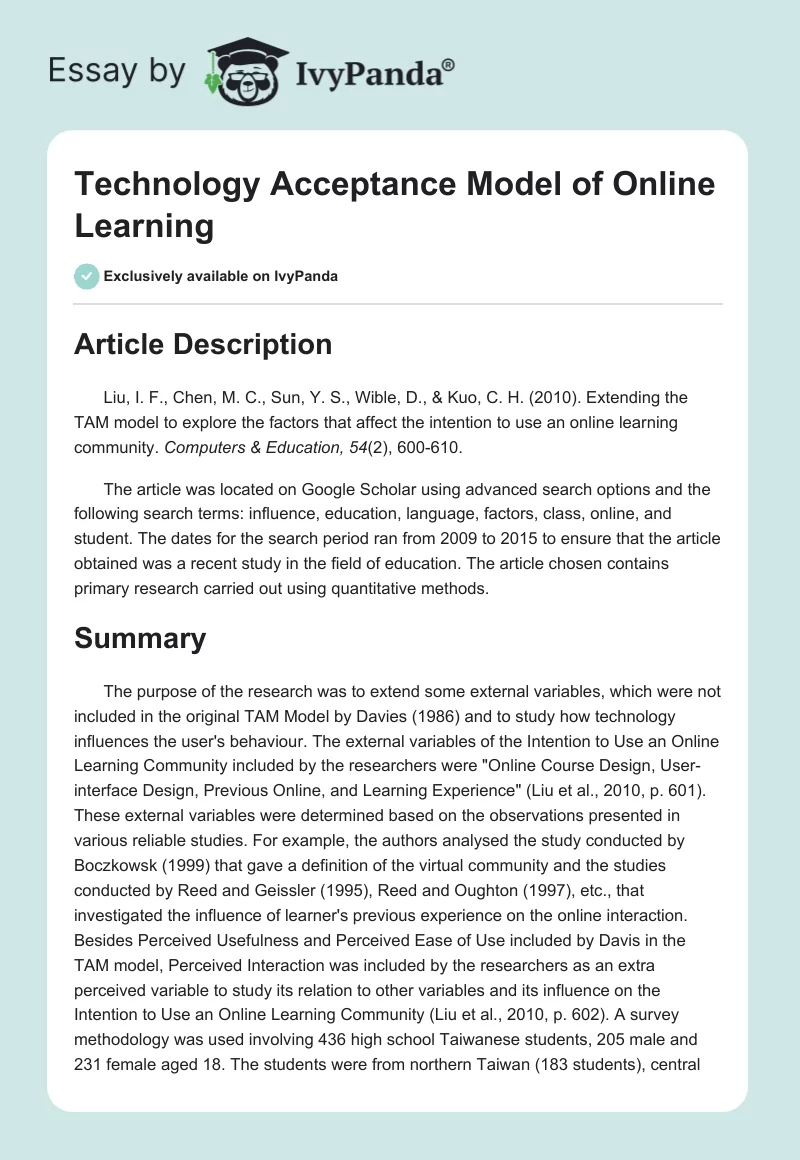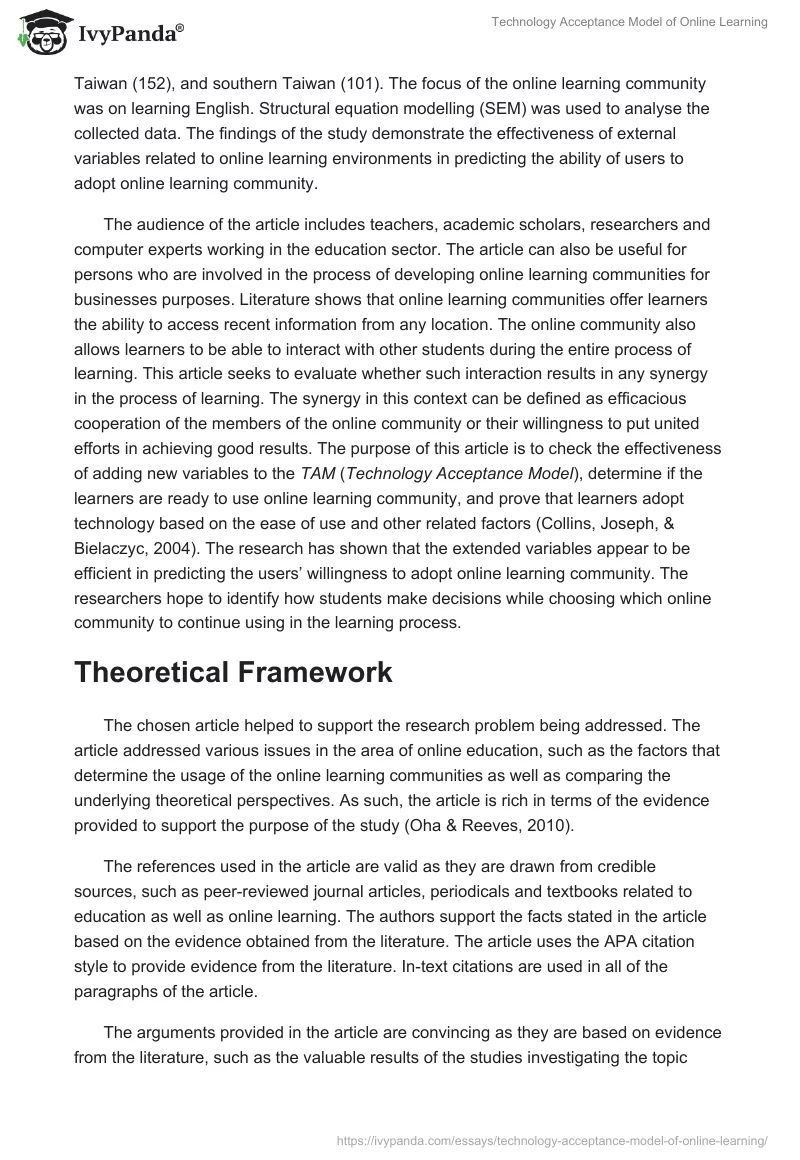Article Description
Liu, I. F., Chen, M. C., Sun, Y. S., Wible, D., & Kuo, C. H. (2010). Extending the TAM model to explore the factors that affect the intention to use an online learning community. Computers & Education, 54(2), 600-610.
The article was located on Google Scholar using advanced search options and the following search terms: influence, education, language, factors, class, online, and student. The dates for the search period ran from 2009 to 2015 to ensure that the article obtained was a recent study in the field of education. The article chosen contains primary research carried out using quantitative methods.
Summary
The purpose of the research was to extend some external variables, which were not included in the original TAM Model by Davies (1986) and to study how technology influences the user’s behaviour. The external variables of the Intention to Use an Online Learning Community included by the researchers were “Online Course Design, User-interface Design, Previous Online, and Learning Experience” (Liu et al., 2010, p. 601). These external variables were determined based on the observations presented in various reliable studies. For example, the authors analysed the study conducted by Boczkowsk (1999) that gave a definition of the virtual community and the studies conducted by Reed and Geissler (1995), Reed and Oughton (1997), etc., that investigated the influence of learner’s previous experience on the online interaction. Besides Perceived Usefulness and Perceived Ease of Use included by Davis in the TAM model, Perceived Interaction was included by the researchers as an extra perceived variable to study its relation to other variables and its influence on the Intention to Use an Online Learning Community (Liu et al., 2010, p. 602). A survey methodology was used involving 436 high school Taiwanese students, 205 male and 231 female aged 18. The students were from northern Taiwan (183 students), central Taiwan (152), and southern Taiwan (101). The focus of the online learning community was on learning English. Structural equation modelling (SEM) was used to analyse the collected data. The findings of the study demonstrate the effectiveness of external variables related to online learning environments in predicting the ability of users to adopt online learning community.
The audience of the article includes teachers, academic scholars, researchers and computer experts working in the education sector. The article can also be useful for persons who are involved in the process of developing online learning communities for businesses purposes. Literature shows that online learning communities offer learners the ability to access recent information from any location. The online community also allows learners to be able to interact with other students during the entire process of learning. This article seeks to evaluate whether such interaction results in any synergy in the process of learning. The synergy in this context can be defined as efficacious cooperation of the members of the online community or their willingness to put united efforts in achieving good results. The purpose of this article is to check the effectiveness of adding new variables to the TAM (Technology Acceptance Model), determine if the learners are ready to use online learning community, and prove that learners adopt technology based on the ease of use and other related factors (Collins, Joseph, & Bielaczyc, 2004). The research has shown that the extended variables appear to be efficient in predicting the users’ willingness to adopt online learning community. The researchers hope to identify how students make decisions while choosing which online community to continue using in the learning process.
Theoretical Framework
The chosen article helped to support the research problem being addressed. The article addressed various issues in the area of online education, such as the factors that determine the usage of the online learning communities as well as comparing the underlying theoretical perspectives. As such, the article is rich in terms of the evidence provided to support the purpose of the study (Oha & Reeves, 2010).
The references used in the article are valid as they are drawn from credible sources, such as peer-reviewed journal articles, periodicals and textbooks related to education as well as online learning. The authors support the facts stated in the article based on the evidence obtained from the literature. The article uses the APA citation style to provide evidence from the literature. In-text citations are used in all of the paragraphs of the article.
The arguments provided in the article are convincing as they are based on evidence from the literature, such as the valuable results of the studies investigating the topic area. The article also provides the divergent opinions on the given hypothesis by presenting the information about the conclusions related to the hypothesis of the study made by other researchers and goes ahead to provide an evaluation that gives a clear stand on different issues. The validity of the study is also enhanced by the fact that the authors identify the arguments, which are not supported by enough amount of evidence, conduct further research in the area to present additional evidence, and present its results, which contribute to extending the amount of valuable information about the chosen area of research.
Evaluation and Critique
The research adopts a quantitative design under which the Intelligent Web-based Interactive Language Learning (I WiLL) community is created and used to test the TAM. The experiment is based on the hypothesis proposed in the model that indicates that one can predict the willingness to use an online learning platform.
The research sample includes 436 senior high school students from Taiwan involved in the process of learning English. The data were analysed using the statistical approach of SEM and the software LISREL 8.54. It is a good strategy as it helps to assess the collected data effectively and receive objective, precise results. A survey methodology using Likert scale was employed. A pilot was done on the survey questionnaires for reliability and achieved a Cronbach Alpha value of 0.90 to 0.92, which suggests that the questionnaire is both reliable and valid. The maximum likelihood method was applied in the estimation of the different parameters of the model. This method helps to determine the value of particular characteristics for certain statistics and maximize the likelihood function. This method appears to be appropriate for the study, as it helps to conduct a well-defined estimation in case of the normal distribution, and this feature corresponds to the specifics of the study.
The research design was chosen appropriately as the study aimed to test the validity of the hypothesis developed from an education model (Liu et al., 2010). The researchers relied on SEM to measure the strength of relationships between variables, as such statistical approach integrates different forms of analysis and helps to achieve a good model fit after analysis and modification (Liu et al., 2010, p. 605). Therefore, usage of such a statistical approach contributes to conducting the comprehensive analysis of the collected data and receiving valid results.
The sample selection was conducted by putting a questionnaire on the IWill Website for two weeks. The subjects were randomly chosen as any student using IWiLL learning community could become part of the research by answering the questionnaire on the website. Such a method of selection let the researchers select a big number of participants while the random character of selection contributed to the objectivity of the study. The study is good and meets most of the requirements of survey design (Oha & Reeves, 2010). However, the study has some weaknesses, as no control sample is used. A control sample will be good for this study, as it will let the researchers isolate the influence of investigated variables. Therefore, the features of the IWiLL learning community cannot be considered the determinants of whether the students will use the platform. The results are clear, comprehensible, and match the hypothesis being tested. I agree with the conclusions made by the authors as they are supported by the evidence-based on the reliable data, such as the results of the empirical study conducted by the researchers and the analysis of gained results compared to other studies. The conclusions are clear and supported by the evidence from literature, as the authors cite different studies carried out on the issue previously.
Conclusion
The study contributes significantly to the evaluation of the TAM model of online learning and the usage of external variables. The research results emphasize the importance of considering course design and interface design together with proving the essential role of using the system previous online experience, perceived interaction, perceived ease of use, and perceived usefulness. The study provides evidence of how learners make decisions on which online learning platform to use in their studies (Oha & Reeves, 2010). The weaknesses of the study include a limited sample, which was not classified in terms of age or educational background and the absence of measurement of the students’ motivation to participate in the study. It would be important to look at these variables, as background and motivational factors directly affect the behavioural patterns demonstrated by the participants. Improving the questionnaire’s design, broadening the sample variety, compiling the users’ learning portfolios, and analysing the motivational factors that encourage the students to participate in different online learning activities can be considered as suggestions for future improvements of the model of this study.
References
Collins, A., Joseph, D., & Bielaczyc, K. (2004). Design research: Theoretical and methodological issues. Journal of the Instructional Sciences, 13(1), 15-42.
Liu, I. F., Chen, M. C., Sun, Y. S., Wible, D., & Kuo, C. H. (2010). Extending the TAM model to explore the factors that affect intention to use an online learning community. Computers & Education, 54(2), 600-610.
Oha, E., & Reeves, T. (2010). The implications of the differences between design research and instructional systems design for educational technology researchers and practitioners. Educational Media International, 4(47), 263-275.


